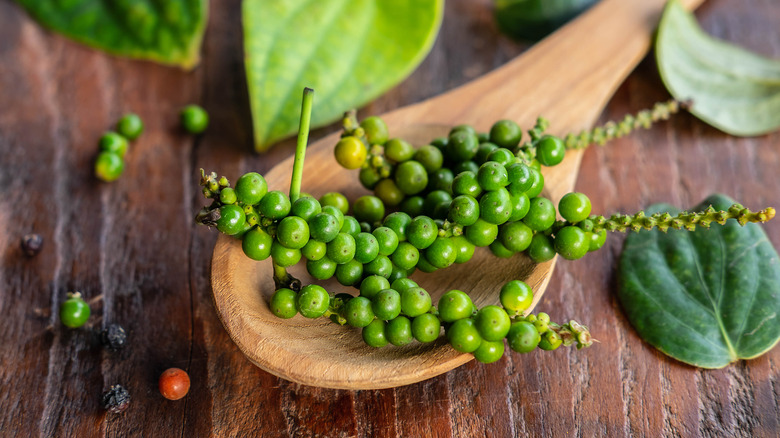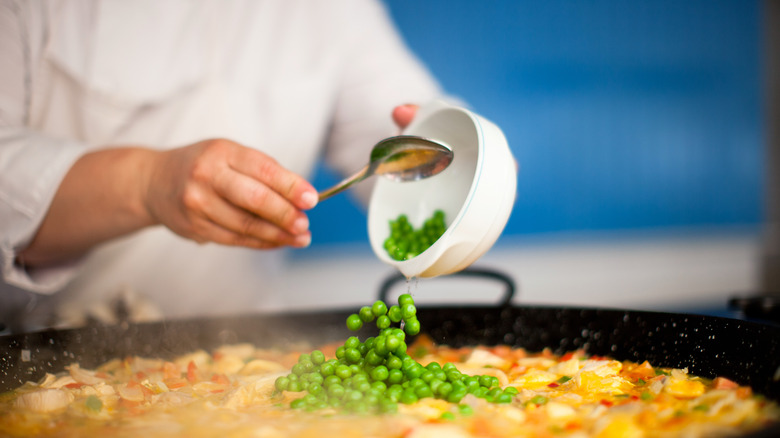Here's The Difference Between Green And Black Peppercorns
When a recipe calls for freshly-cracked pepper, it's usually referring to the black peppercorns you keep in a grinder next to your salt shaker. But just as salt comes in myriad of varieties — from flaky kosher salt to fancy pink and black salt from the Himalayas — peppercorns also come in different colors and flavors. There are sweet pink peppercorns and aromatic, mouth-numbing Timut and Szechuan peppercorns, but these three spices actually don't come from the same family as black pepper. An example of a "true" peppercorn variety is green peppercorns, which come from the species piper nigrum, the same plant that produces classic black and milder white peppercorns.
While it may look like an entirely different spice, these verdant little orbs are simply unripe black peppercorns that are usually dried, freeze-dried, or brined upon harvesting to preserve their color and flavor. As its hue suggests, green pepper brings a certain freshness to the table that plays well with fish, stews, sauces, pickles, and all sorts of other dishes. Speaking with the Washington Post, chef and cookbook author Adrienne Cheatham described the flavor of this rare ingredient as a mix between raw capers and black pepper. Brined green peppercorns are more fruity and zesty, with a crunchy but tender texture, while dried ones are more earthy and spicy.
A strong flavor and a shorter shelf life
While dried black pepper will stay fresh in your pantry for up to four years, according to the USDA, green peppercorns have a slightly shorter shelf life. Once opened, some retailers say a container of the spice will lose its potency after one to two years, while green peppercorns refrigerated in brine will maintain their fresh, vegetal flavor for up to three years.
If you're lucky enough to get your hands on fresh, untreated green peppercorns, you'll need to store them in an airtight container in the fridge and use them up even more quickly, preferably within a week. Of course, the fresh peppercorns are rare to find at U.S. retailers. Even in a specialty food market in a culinary hub like New York City, you'd be hard-pressed to find a branch. The two establishments that once kept the fresh spice on their shelves — one of which being Dean & Deluca — have shuttered. Curious home cooks are better off sticking to the packaged stuff, which can be found at many Asian markets and specialty food stores.
How to use green peppercorns
You can often use green peppercorns in the same way as black ones. Try grinding some crushed green peppercorns over your morning eggs, or chopping up some brined, fresh drupes and adding them to your grilled cheese, as one Reddit user suggests. But if you want to make the ingredient shine, you might consider using it for a more involved dish. Classic French steak au poivre (pepper steak), named for the coarsely-crushed pepper that flavors its creamy sauce, can be made even more exciting with green pepper. While black pepper lends a warm, woodsy flavor to the dish, its green counterpart adds a brightness that plays well with the finely chopped parsley or chives that also dress the seared steak.
Cutting back on red meat? You might try turning to a recipe inspired by the flavors of Southeast Asia, where green peppercorns are popular in the cuisines of several regions. For instance, some Thai green curry recipes call for brined green peppercorns to cut through the creamy richness of the coconut milk-based sauce. And if you're working with dried peppercorns, try soaking them in water for around 15 minutes to soften them and bring out their flavor.


